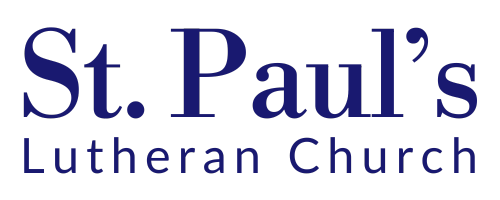Church Windows
The Windows of St. Paul's
The beautiful stained glass windows of St. Paul’s Evangelical Lutheran Church are one of Wilmington’s outstanding art treasures. The art of stained glass is as old as the Middle Ages when the Christian Church began to illustrate Biblical stories and symbols in the great Gothic Cathedrals of Europe. The Windows of St. Paul’s are inheritors of that grand tradition with fourteen figure windows depicting the story of the life of Christ.
Organized largely by German immigrants on May 31, 1858, with fifty-eight Charter Members, St. Paul’s purchased property almost immediately on the northeast corner of Sixth and Market Streets for the erection of a church building. The proposed sanctuary was to be a rectangular Gothic Church, with a vestry room in the rear, according to a plan submitted by Mr. H. Vollers, an architect and member of the church. The cornerstone was laid on September 8, 1859. By late 1860, the steeple was completed, the walls were up, the roof was covered with slate, and divine services were being held in the vestry room. In April, 1861, the outbreak of the War Between the States brought all work on the church to an abrupt halt, most probably because of the scarcity of money and materials.
After the fall of Fort Fisher in the winter of 1865, Wilmington was occupied by Northern Troops, some of whom camped in the churchyard. They used pews, joists, and reading desks as fuel for their campfires, burned in the yard. The soldiers stabled their horses in the building and left it in shambles. It was a difficult time for the church and was made even more so when the Rev. John Mengert resigned leaving the little congregation without a pastor. A number of its most dedicated members were casualties of the severe Yellow Fever Epidemic, which raged in Wilmington during the early 1860’s. A portion of the property had to be sold to pay debts, and the Confederate money received for the sale proved worthless after the War.
The Rev. G. D. Bernheim, the North Carolina Lutheran Synod Representative, who had been instrumental in forming St. Paul’s, learned of the serious situation facing the church; and he hurried to Wilmington. Under his energetic leadership, the fledgling church weathered the tragic times. In 1869, work was begun again on the building under the supervision of Mr. James Post, a local architect. Finally, the building was dedicated on August 22, 1869.
At this time, there were stained glass windows installed, which were described in the Lutheran Visitor, by the Rev. L. Muller of Charleston, South Carolina, who attended the dedication services. The windows are “pure Gothic Double Windows with rhombs above for emblems. How charming!” None of these windows survive in the nave, but the tower windows are thought to be of the original design. The emblems in the top tracery are original, but the cathedral glass in the bottom has been replaced.
The transept, added in 1907-08, changed the interior plan of the church from simple to basilica. The addition was designed by Mr. Henry E. Bonitz, a church member who was one of the most prominent and prolific of early 20th Century Architects in Wilmington.
It was during this renovation that the plan of the current stained glass windows was begun. Records in St. Paul’s Archives indicate that the Frank Ellsworth Weeder Stained Glass Studio of Philadelphia received in 1908, the sum of $802.32 in payment for a shipment of two figure windows and five ornamental ones. Mr. Frank E. Weeder was born in Philadelphia in 1868, died in 1952, and was buried in Mount Moriah Cemetery, Philadelphia. We have learned he worked in the Philadelphia area from 1892 until 1940; he was a man of modest means, judging from his estate; and he never married.
The windows are made of opalescent glass, which contains streaks of color, that when fused, give a milky iridescent appearance. Portions are built-up of two layers of glass to achieve shading and depth. In the last half of the 19th Century, this plating process was developed by John LaFarge (1835-1910) and was later adopted by Louis Comfort Tiffany (1848-1933). This is essentially an American method of constructing stained glass which allows a richness of color different from that seen in the painted European Windows in vogue at that time.
The fourteen figure windows are in a style that transcribes well-known paintings by major artists into the medium of stained glass. For example, the “Gethsemane” Window is based on the painting by Johann Heinrich Hofmann (1824-1902), a German historical artist of some note. “Jesus, the Light of the World” is by the English painter, William Holman Hunt (1827-1910), the original of which hangs in Kebler College, Oxford University, England.
The first two figure windows to be installed were “Gethsemane” over the altar and the “Good Shepherd” in the Baptistry. Also, at this time, five ornamental windows were purchased—two in the rear wall, one in the Sacristry, and two on the east side. One ornamental window on the east side was known as the “Organ Window” because at that time it was next to the organ and could be seen from the interior of the church. It has a slightly different design and was given by the Ladies of the Mengert Missionary Society.
The frames of the windows were sent to Philadelphia completely boxed to permit the return of the glass and frames in the same boxes. The return trip was begun on January 6, 1908, and was made on the SS Navahoe, a freighter operated by the Clyde Steamship Lines. Southern Express Company delivered the windows to the Church on February 3, 1908. They were quickly installed and were dedicated on Septuagesima Sunday, February 16, 1908.
Because of the expense of the windows, the two large triple windows in the transept were not purchased in 1908. The Weeder Company furnished olive green cathedral glass to be used until proper figure windows could be obtained.
The “Nativity” or Founders’ Window in the West transept was the next to be placed. In February of 1909, the Dorcas Society started a stained glass window fund, stating that all surplus monies be devoted to this cause. The lowest cost quoted by Mr. Weeder would be $600. Originally, only the names of the Charter Members were to be included; but in October of 1909, it was decided that any member could have his or her deceased relatives’ names placed on the window by contributing $25 towards the fund. The Society donated $25 to have the name of Mrs. G. D. Bernheim on the window because she was the founder of the Dorcas Society. This window was shipped on January 31, 1910, and installed shortly afterwards.
About the same time the Dorcas Society was ordering the “Nativity” Window, the other window in the East transept was secured. Mr. Carl Friedrich von Kampen died on July 18, 1909, and his nephews and niece donated “The Resurrection” in his memory, which was dedicated in 1910. At last, the temporary olive green cathedral glass had been replaced.
In March, 1910, the Parish Items announced the ordering of another window, a gift of Mr. H. L. Vollers, in memory of his parents, Hanke and Anna Elizabeth Vollers. The picture subject was to be Hofmann’s “Twelve year old Christ in the Temple,” and it was installed in the first window in the nave on the west side of the church by October, 1910.
The second window in the nave on the west side of the church was given by Mr. J. H. Rehder in memory of his father and mother, Henry and Johanne Rehder. The Church Council Minutes of October 7, 1913, show that Mr. Rehder was given permission to place the window in the church; it was “Jesus Blessing the Children” and was probably dedicated sometime in 1914.
With the placement of the Rehder Window, it left eight figure windows and two ornamental on the front elevation to complete the original plan. In August of 1920, the Church Council approved a motion that “the Pastor, Building and Financial Committees are authorized the privilege to solicit donors of Art Windows.” There is a contract which is unsigned and dated August, 1920, which specifies the ten windows. Apparently, the donors for the windows were secured by February, 1921, as indicated in the minutes of the annual meeting held that year.
Elaborate ceremonies marked the dedication of the completed window theme on August 14, 1921. A representative from each donor family removed a veil which hid the window from view. Dr. Conrad Seegers, then Pastor of St. Paul’s, commented on each window as it was unveiled and elaborated on the subjects portrayed. In the afternoon, the church was opened so “the public could avail themselves the opportunity to inspect the windows.”
Since the last of the windows were installed sixty-eight years ago, periodic maintenance has been necessary. Releading, reglazing, and repairs have been done on several occasions. The restoration completed on March 1, 1989, was by the Reinarts Stained Glass Studios, Winona, Minnesota, when glass coverings were also installed to protect the windows from the elements and vandals.
Through the years, the Windows of St. Paul’s have been an inspiration and a joy not only to the members of the church, but to the hundreds of visitors who have worshipped within the walls of this beautiful and historic church.


